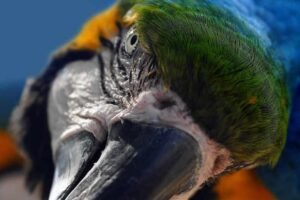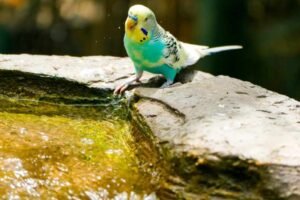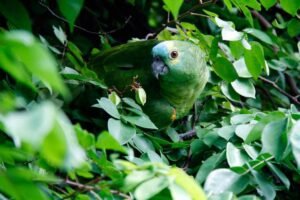African grey body language explained. African greys have a variety of body expressions and noises, helping them represent their mood. When these beautiful birds are happy, their feathers look ruffled and calm. They’ll also purr and vocalize their happiness cheerfully. When angry, they bite, drop their wings, and squint their eyes as a sign of aggression. Scared African greys also display similar body expressions. They flat their feathers near to their body. Parrots are also known for throwing up their food, which is a natural behaviour with their bonded pals and humans.
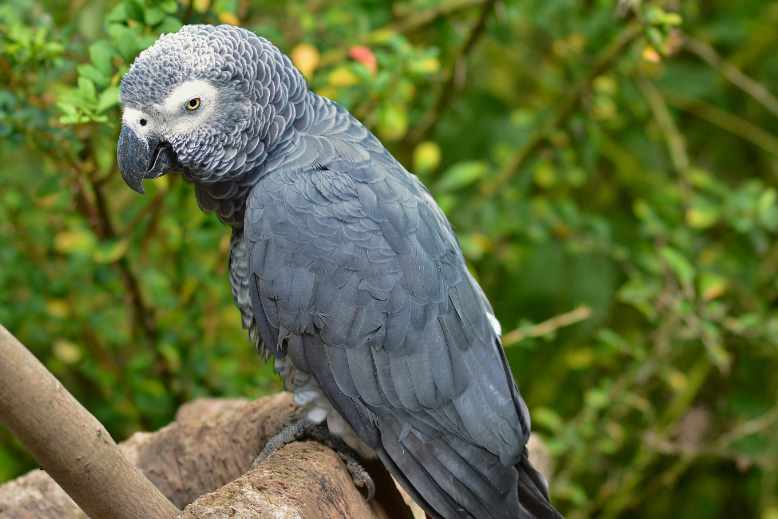
African grey parrots are amongst the most intellectual species of parrot. Affectionately identified as the “Einstein” of the bird world, they have remarkable speaking abilities equivalent to young kids. This implies that these birdies are great at interacting with their owners through their heartwarming gestures and the joyful sounds they make.
Understanding your African Grey parrot body language can help you win the trust of this magnificent bird. Plus, learning about certain gestures and noises can help you prevent African grey behavioural concerns.
African Grey Body Language
As stated earlier, greys communicate with their loved ones in different ways. This means that you can easily figure out what your parrot probably be thinking and experiencing with the most common African grey body language explanations:
Head and Beak
An African grey’s head and beak expressions display a wide range of emotions and sentiments, letting you identify your parrot’s mood at any given period.
Head and beak gestures include:
- Bowing and Bobbing
Housebroken African grey parrots bow and bob their heads a lot, and by doing so, they gain their owners’ attention. Sadly, ill parrots also shake their heads, so owners will need to have a closer eye to find any signs of discomfort and distress.
Head weaving can also end up being a repetitive, obsessive behaviour if African greys are irked or are left behind in their boring enclosures for long durations. According to the University of Guelph, parrots exhibit unusual tendencies when they cannot scavenge or make friends.
- Beak Wiping
You have probably noticed your African grey rubbing its beak right after it had something to snack on. Greys do this to remove any food particles from their mouth. If the birdie is in the enclosure, it’ll try to clean off its bill on the bars or perches. If you’re in the middle of having fun with it, your pet is likely to wipe its beak on your shoulder or on your arm. African greys also wipe and tap their beaks to keep them filed up to a reasonable length. This behaviour is widespread and natural. As a matter of fact, all parrots need to do this to make sure that their beaks work appropriately.
- Beak Grinding
Beak grinding is when an African grey clenches its bill, sliding the lower bill and tongue against the top beak. It generally happens as the parrot settles down for the evening, which is a sign of satisfaction. The grinding sound is usually soft and peaceful, leaving absolutely no cause for consideration.
- Biting
Biting prevails among African greys, but it’s not always due to aggressiveness. Parrots use their beaks to hold onto different things and grab toys, food, and other items. A bird might unintentionally nip you if your hand’s in the way. Nonetheless, biting is also a form of hostility brought on by several things, including poor lifestyle conditions, hunger, or a lack of socialization.
Another probability for biting is that your African grey’s afraid of you. If your parrot appears with an open beak alongside a bent pose and hissing, it’s readying to bite you.

African grey behaviour meanings
- Blushing
African greys usually blush to interact. Typically, it is not easy to notice their blushing due to their thick face fluffs. But when these guys blush, the exposed white patch of skin around the eyes and nose switches a light pink colour thanks to the haemoglobin present in their bird bodies.
As written down by PLOS One, research workers found that parrots have rosy cheeks more often when communicating and engaging with their owners. The excitement from this interaction is one of the most common reasons for blushing in African greys. Regardless, blushing is also the sign of:
- Exhilaration
- Dangers
- A sense of fun
- Sexual selection
- Anger
Your parrot will also display a variety of other indications when blushing, allowing you to determine its mood precisely.
- Yawning
While the intention of yawning is quite a mystery, many African greys yawn when they’re exhausted. It signifies changing conditions within the body. Frequent yawning means that your parrot may not really be getting enough naps. African greys also yawn when they’re:
- Cheerful
- Nervous
- Preening or grooming
- Stretching muscles
Having said that, yawning in some cases indicates that something’s stuck in your parrot’s crop or oesophagus. If your parrot seems distressed or looks to be strangling, take it to a qualified vet for a comprehensive examination.
- Head-Shaking
African greys often shake their head and display this behaviour more than most other parrot species. Though shaking is usually linked with pain or distress, it’s simply a form of preening. While preening, the bird will shudder its skull to rearrange the feathers around its ears, neck, and collar. African greys are really particular about this area, so they shake their heads often to get their feathers in the ideal position. In some cases, African greys shiver their heads to show their displeasure or reject something. The dissimilarity between this condemnation and grooming is evident.
- Regurgitation
Regurgitation signifies love and appreciation. Before expelling their food, African greys hold down their eyes and snuff their long necks out. Parrots do this to connect with their companion and feed their young. If your parrot regurgitates for you, it honours you as someone it trusts and adores.
Wings
An African grey’s wings are another essential component in its body language. Observing your parrot’s wing movements can help you determine if it’s happy and healthy or not.
- Wing Lift
When your African grey raises its wings above its back, it’s giving you a friendly greeting. You’re most likely to see this when you enter the room for the first time each day.
- Wing Flapping
Many African grey parrots flap their wings to exercise, stretch, or cool down. Wing flapping is typically a good sign and indicates that your parrot is happy and content. Similarly, your parrot may also be attempting to get your attention by flapping its wings.
- Wing Drooping
Wing dropping isn’t a good sign in African grey parrots, as it means they’re exhausted, overheated, or ill. However, wing drooping is normal after a bath, as it indicates your parrot’s drying itself off.
- Quivering Wings
Wings held out by the African grey and quivering are part of a mating dance. It’s rarely a sign of sickness unless the entire body shakes simultaneously.
However, if the parrot holds its wings horizontally, it might be getting ready to fly away from a perceived threat.
- Opened Wings
Open, out-stretched wings give the appearance of size. It’s a form of aggression or fear commonly used against other birds, animals, or humans. Parrots that fight for dominance will hold their wings out as wide as possible to make themselves look bigger and more formidable.
Eyes
An African grey’s eyes are among the most meaningful attributes, enabling you to identify precisely what your little birdie is feeling.
One of the most famous eyes expressions are:
- Pinning
African greys are able to control their irises, making them expand rapidly and shrink at their own will. They do this in response to stimuli, but it can signify a range of emotions involving joy, curiosity, fear, and contentment. For the most part, eye pinning occurs when the parrot is interested in something within its surrounding. You’ll know this because its outlook will be relaxed. On the other hand, if your African grey pulls its feathers while pinning its eyes, it’s angry or feeling scared. At this point, it’s most likely to bite or become aggressive.
- Wide-Eyes
Wide, round eyes signify that the African grey parrot is surprised. This could be because it didn’t notice you walk into the room, or it’s seen something it really did not expect to see.
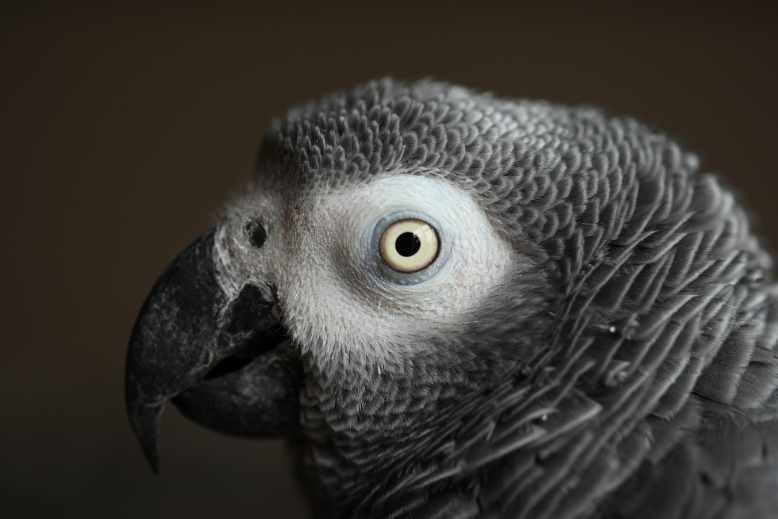
- Squinted Eyes
When African greys are annoyed or upset, their eyes become more squinted than usual. This could turn into aggression unless the cause of the annoyance is gotten rid of. However, squinted eyes are also a sign of drowsiness.
Feathers
The language of feathers is complex and hard to interpret. In many cases, an African grey’s feather movements are too subtle to notice and read. However, the most apparent feather expressions include:
- Ruffled Feathers
African greys ruffle and fluff their feathers to relieve tension. This action acts as a short stretch, making the parrot feel more comfortable.
They also ruffle their feathers after preening to remove loose dirt and debris. African greys are dusty birds, so you might notice dust falling from the feathers, and this is normal and nothing to worry about.
If your African grey’s feathers remain fluffed up for several hours, it’s likely cold or ill.
- Flattened Feathers
African greys flatten their feathers when they’re afraid. Instead of being loose and relaxed like they should be, they’ll be held tightly to the parrot’s body. If cornered, the parrot will likely turn aggressive.
Feet
The way your parrot’s feet grip its perches and cage bars can be telling when it comes to their thoughts and emotions. When trying to gauge your African grey’s mood, watch for the following things:
- Chicken Scratching
African greys sometimes scratch at the bottom of their cage or carpet. This is a natural wild behaviour carried over to captivity to loosen dirt and debris.
- Standing on One Foot
When an African grey parrot stands on one foot, it feels relaxed and comfortable, and this is confirmed by loose feathers that aren’t held too tightly to the body. Parrots also stand on one leg to reduce the heat it loses from their bare body parts.
- Tight Grip
Fearful or scared African greys grip their perches tightly as a natural reaction. If the perches aren’t the right shape or width, the chances of developing bumblefoot are increased.
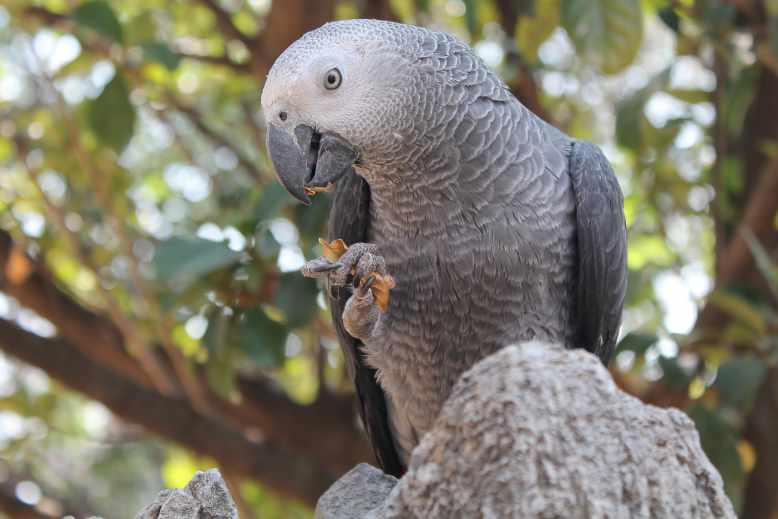
- Hanging Upside Down
African greys enjoy hanging upside down from time to time. It’s nothing to worry about as it signifies happiness and relaxation, even if it looks uncomfortable.
What are different African grey noises meanings?
African greys aren’t overly loud birds, but they’re advanced talkers, mimicking sounds, numbers, and essential words and phrases. While they don’t make many sounds, you can tell what they’re feeling with the following noise meanings:
- Screaming
African greys scream when they’re scared or startled. This is usually because something in the environment is making them feel stressed. If your parrot calls out of fear, try:
- Moving the cage to somewhere quieter.
- Placing a cover over its cage when it sleeps to prevent night terrors.
- Avoid putting on the TV or radio in the same room as the parrot at night.
- Keep other pets away from the parrot.
When African greys scream for long periods, they’re likely bored. In particular, African greys are intelligent animals that require constant mental stimulation and interaction. Constant screaming is a sign that the parrot’s neglected and needs entertainment.
- Singing and Whistling
African greys love to sing and whistle and regularly copy the songs and sounds they hear on the TV and radio. These sounds aren’t shrill but are pleasant to listen to and showcase their mimicking abilities.
Similarly, whistling is a happy sound. They do this when they’re comfortable and relaxed.
- Growling
African grey parrots make a unique growling sound whenever they’re frightened. Growling is unusual in the avian world and almost exclusively to Congo and Timneh parrots. Because of this, some owners misdiagnose their African grey parrot as having a respiratory disease.
- Purring
When African greys are happy and content, they purr. It’s lower than the angry growl and can be heard when you stroke and pet your parrot.
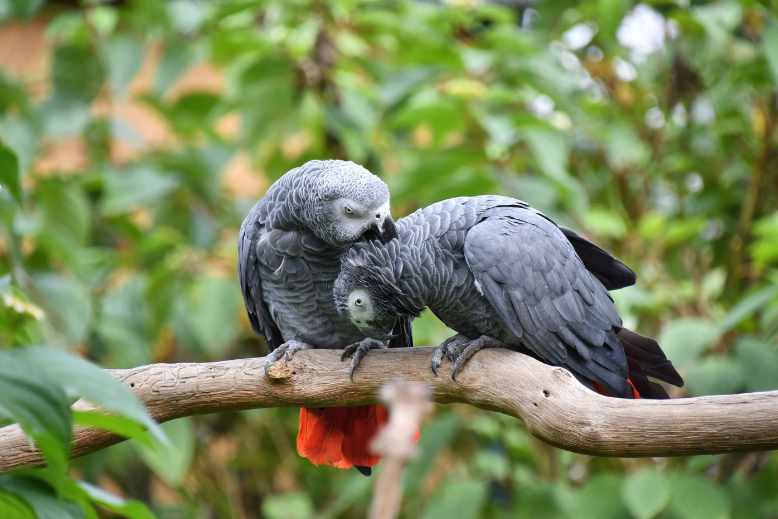
Wrapping UP
African grey can be fabulous playmates, very lovable and cuddly, to suddenly be distant, even aggressive. It should be borne in mind that they are above all wild animals by instinct, whether raised by parents or by hand. They are therefore sensitive and intuitive, attentive to their environment.
This is why we, as responsible humans, need to listen and take the time to listen and watch the body language of the African Grey parrot and what signals they send us.

